
Amaryllis is the only genus in the subtribe Amaryllidinae. It is a small genus of flowering bulbs, with two species. The better known of the two, Amaryllis belladonna, is a native of the Western Cape region of South Africa, particularly the rocky southwest area between the Olifants River Valley and Knysna. For many years there was confusion among botanists over the generic names Amaryllis and Hippeastrum, one result of which is that the common name "amaryllis" is mainly used for cultivars of the genus Hippeastrum, widely sold in the winter months for their ability to bloom indoors. Plants of the genus Amaryllis are known as belladonna lily, Jersey lily, naked lady, amarillo, Easter lily in Southern Australia or, in South Africa, March lily due to its propensity to flower around March. This is one of numerous genera with the common name "lily" due to their flower shape and growth habit. However, they are only distantly related to the true lily, Lilium. In the Victorian Language of Flowers, amaryllis means "pride, determination and radiant beauty".
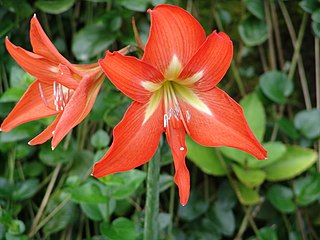
Hippeastrum is a genus of about 90 species and over 600 hybrids and cultivars of perennial herbaceous bulbous plants. They generally have large fleshy bulbs and tall broad leaves, generally evergreen, and large red or purple flowers.

Eucharis is a genus of about 15-20 species of neotropical plants in the Amaryllis family, native to Central America and South America, from Guatemala south to Bolivia. Some species have become naturalized in Mexico, the West Indies, and scattered tropical islands. The English name Amazon lily is sometimes used for all species in the genus, but is particularly used for Eucharis amazonica and Eucharis × grandiflora, which are often confused.
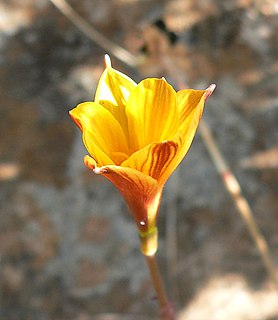
Habranthus (copperlily) is a genus of tender herbaceous flowering bulbs in the subfamily Amaryllidoideae of the family Amaryllidaceae. The genus was first identified by pioneering bulb enthusiast William Herbert in 1824. The species are native to the Americas, from, but several species are naturalized in other parts of the world West Indies, India, South Africa, Mauritius, Colombia, Easter Island, and the southeastern United States.

Rhodophiala is a genus of herbaceous, perennial and bulbous plants in the Amaryllis family. It consists of about 30 South American species distributed in southern Brazil, Argentina, and, specially, in Chile. Most of the species are known colloquially as añañuca.

Rhodolirium is a small South American genus in the tribe Hippeastreae of the family Amaryllidaceae. Although originally described by Philippi in 1858 it has long remained buried in other taxa, principally Hippeastrum and more recently Rhodophiala. Only in recent years has it been rehabilitated.
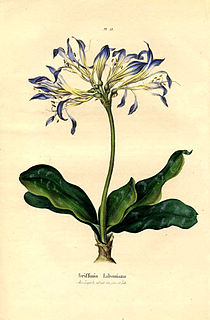
The tribe Griffineae includes 2 genera with 22 species from South America which are actually endemic to Brazil. A typical character of the representatives of the tribe are the flowers - They are with blue or lilac color collected into an umbel. Only the members of this tribe and the genus Lycoris are able to form flowers with such color in the whole family Amaryllidaceae. The plants in this group are typical perennial flowers which are producing bulbs. The leaves are green, with elliptical form in the most of the cases but in some members as in Worsleya they are sword-shaped.
Alan W. Meerow is an American botanist, born in New York City in 1952. He specializes in the taxonomy of the family Amaryllidaceae and the horticulture of palms and tropical ornamental plants. He also works on the population genetics and molecular systematics of cycads and palms.

The Amaryllidaceae are a family of herbaceous, mainly perennial and bulbous flowering plants in the monocot order Asparagales. The family takes its name from the genus Amaryllis and is commonly known as the amaryllis family. The leaves are usually linear, and the flowers are usually bisexual and symmetrical, arranged in umbels on the stem. The petals and sepals are undifferentiated as tepals, which may be fused at the base into a floral tube. Some also display a corona. Allyl sulfide compounds produce the characteristic odour of the onion subfamily (Allioideae).
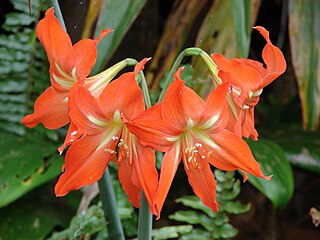
Hippeastreae is a tribe of plants belonging to the subfamily Amaryllidoideae of the Amaryllis family (Amaryllidaceae). Species in this tribe are distributed in South America. Flowers are large and showy, zygomorphic, with the stamens in varying lengths, inflorescence bracts are often fused basally. The seeds are flattened, winged or D-shaped. Reported basic chromosome numbers are x= 8-13, 17, and higher. All the species in this tribe present a remarkable aesthetic interest and horticultural value.

Pyrolirion, commonly known as fire lilies or flame lilies, is a small genus of herbaceous, bulb-forming South American plants in the Amaryllis family, native to Chile, Peru, and Bolivia.

Amaryllidoideae is a subfamily of monocot flowering plants in the family Amaryllidaceae, order Asparagales. The most recent APG classification, APG III, takes a broad view of the Amaryllidaceae, which then has three subfamilies, one of which is Amaryllidoideae, and the others are Allioideae and Agapanthoideae. The subfamily consists of about seventy genera, with over eight hundred species, and a worldwide distribution.

Hippeastrinae is a subtribe of plants classified under the tribe Hippeastreae. It belongs to the subfamily Amaryllidoideae of the Amaryllis family (Amaryllidaceae).
Hippeastrum iguazuanum is a flowering perennial herbaceous bulbous plant in the family Amaryllidaceae. It is found from southern Brazil (Parana) to Argentina (Misiones), although it has been reported in other Brazilian states.

Hippeastrum papilio is a flowering perennial herbaceous bulbous plant, in the family Amaryllidaceae, native to southern Brasil.
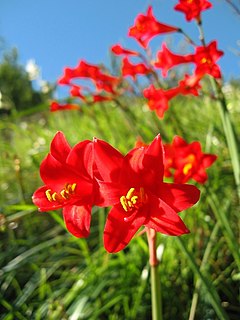
Phycella is a genus of herbaceous, perennial bulbous flowering plants belonging to the family Amaryllidaceae, subfamily Amaryllidoideae. The genus consists of five species distributed from central Chile to northwestern Argentina.
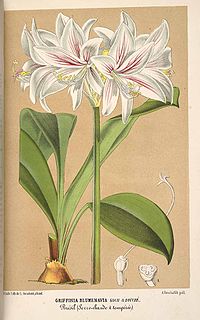
Eithea is a plant genus in the Amaryllis family, endemic to southern Brazil. It contains two known species: Eithea blumenavia Ravenna, native to the States of Paraná, Santa Catarina, and São Paulo, and Eithea lagopaivae Campos-Rocha & Dutilh, native to the States of São Paulo.

Gilliesieae is a tribe of herbaceous geophyte plants belonging to the subfamily Allioideae of the Amaryllis family (Amaryllidaceae). Described in 1826, it contains fifteen genera and about eighty species. It has been variously treated as a subfamily or tribe. It is native to the Southern United States, Central and South America, predominantly Chile. Of the three tribes of genera that make up the subfamily Allioideae, Gilliesieae is the largest and most variable. The tribe was divided into two tribes in 2014, Gilliesiae s.s. and Leucocoryneae, based on differences in floral symmetry and septal nectaries.

Traubiinae is a subtribe of plants classified under the tribe Hippeastreae. It belongs to the subfamily Amaryllidoideae of the Amaryllis family (Amaryllidaceae).

Famatina is a small genus of South American bulbous plants identified by the Chilean botanist Ravenna in 1972. Five species have been described. The exact taxonomic relationship remains uncertain. Phylogenetically they are placed within the Amaryllidoideae tribe Hippeastreae.

















